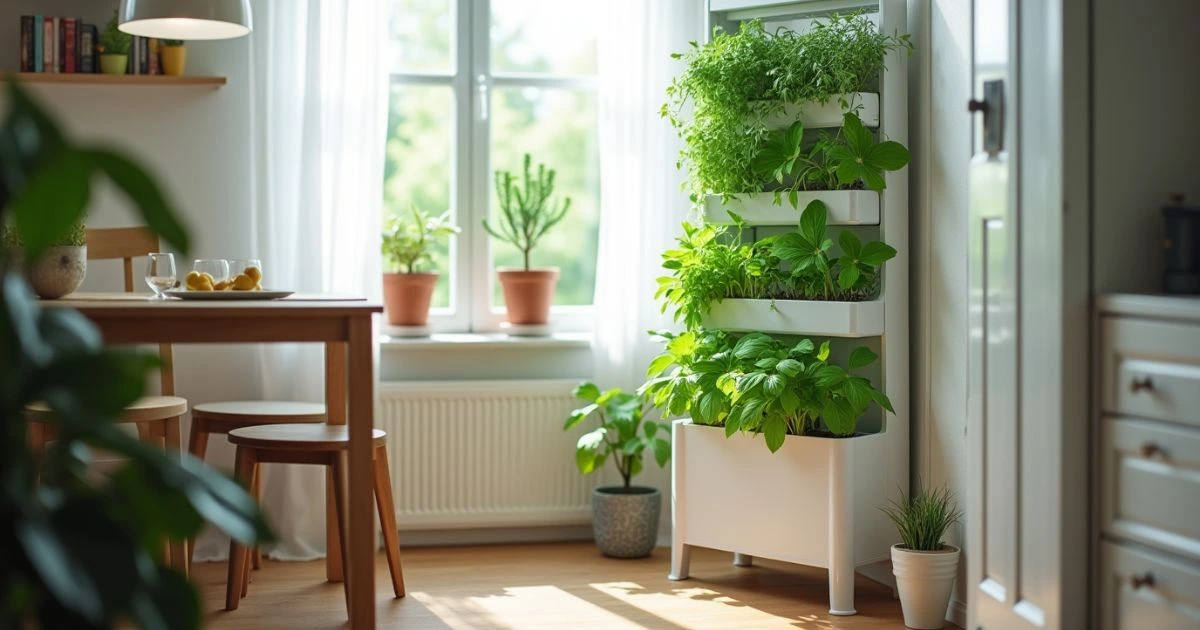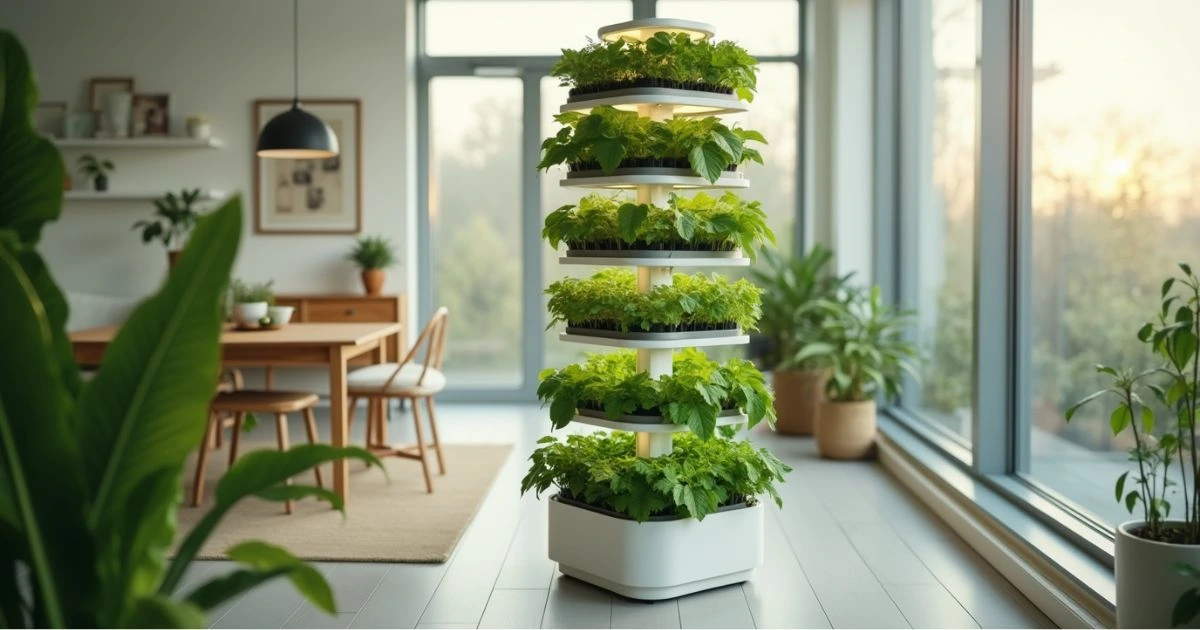Imagine the joy of harvesting fresh, vibrant vegetables right from your balcony or kitchen, all year round. With a hydroponic garden tower, this dream can easily become a reality. Whether you want to grow lettuce on your balcony or strawberries in your kitchen, this innovative system makes gardening not only efficient but also a lot of fun. In this comprehensive guide, we will explore five amazing benefits of using a hydroponic garden tower, and how it can transform your gardening experience.
Table of Contents
What is a Hydroponic Garden Tower and How Does It Function?
Understanding Hydroponics
Hydroponics is a revolutionary method of growing plants without the use of soil. Instead, plants are cultivated in a nutrient-rich water solution that supplies all the essentials for their growth. In a hydroponic garden tower, plants are arranged vertically, maximizing space while ensuring they receive the necessary nutrients, oxygen, and light. This system is particularly beneficial for small spaces or areas where traditional gardening might not be feasible.
Why Choose a Hydroponic Garden Tower?
Hydroponic garden towers are designed to save space and provide an efficient, easy-to-manage growing system for people with limited room or time. In addition to their space-saving design, these systems allow for faster plant growth, better water conservation, and year-round gardening, making them an ideal solution for anyone looking to grow their own food in a sustainable way.
Benefit #1 – Space-Saving Design
Grow More with Less Space

Traditional gardens require large plots of land, but a hydroponic garden tower solves this issue by using vertical space. Instead of growing plants horizontally, a hydroponic tower stacks them vertically, allowing you to grow multiple plants in a very small area. This means you can grow more food in less space, perfect for city dwellers, apartment owners, or anyone with limited outdoor space.
Perfect for Urban Living
Urban living can sometimes mean very little space for outdoor gardening. With a tower farm or tower plant system, you can utilize even the smallest outdoor spaces, such as balconies, patios, or even windowsills, to grow your own fresh vegetables, herbs, and flowers. For example, a 4-foot tower can house up to 36 plants, and it takes up only about 2 square feet of space on the ground.
Imagine turning a small balcony into a mini vegetable farm or placing a hydroponic garden tower in the corner of your kitchen to grow fresh basil, parsley, and cilantro year-round. Whether you’re an experienced gardener or a beginner, the vertical design of a tower garden offers versatility in both indoor and outdoor settings.
Best Crops for Small Spaces
The beauty of a hydroponic tower is that it can support a wide variety of crops, even in confined spaces. Here’s a quick guide to the best plants for small spaces in a hydroponic garden tower:
| Plant Name | Growth Time | Conditions Needed |
| Lettuce | 3-4 weeks | Cool temperatures |
| Spinach | 4-6 weeks | Moderate sunlight |
| Strawberries | 8-10 weeks | Moderate sunlight |
| Kale | 4-6 weeks | Cool, moist conditions |
| Tomatoes (dwarf) | 8-12 weeks | Warm temperatures, full sun |
As you can see, plants that require little space but high yield are perfect candidates for a hydroponic tower.
Benefit #2 – Water Efficiency
Save Water, Save the Planet

One of the most significant advantages of using a hydroponic garden tower is water efficiency. Traditional gardening uses a lot of water, with much of it being lost to evaporation or runoff. Hydroponic systems, on the other hand, recycle water, reducing waste. In fact, hydroponic gardens use up to 90% less water than conventional gardening, making them an environmentally friendly and cost-effective choice.
How It Works
- Nutrient Circulation: Water mixed with nutrients is pumped up the tower and distributed to the plants’ roots. Once the water has nourished the plants, it is collected and filtered to be reused, which minimizes water loss.
- Wicking Systems: Some hydroponic garden towers use a wicking system where water is gradually drawn up from a reservoir to the plant roots via capillary action. This ensures that the plants receive the right amount of water without excessive runoff.
For instance, a hydroponic tower might need just a couple of gallons of water to sustain 36 plants, while a traditional garden would need many more gallons for the same number of plants. The water in a hydroponic system is reused and replenished less frequently, helping to conserve valuable resources.
Practical Example
Consider growing lettuce or herbs on your balcony. With a tower plant system, you could have an entire herb garden requiring only a few liters of water a week. This is significantly less than the amount of water needed for an in-ground garden, where watering needs to be done daily during hot weather.
Benefit #3 – Faster Plant Growth
Why Do Plants Grow Faster?

Plants grown in a hydroponic garden tower often grow much faster than those grown in traditional soil-based gardens. The reason? The nutrient-rich water solution allows plants to access nutrients directly at their roots, which promotes faster absorption. This means plants have everything they need to grow quickly and healthily.
Three Key Factors Boosting Growth
- Precise Nutrient Delivery: In hydroponics, the water contains a balanced mix of essential nutrients. This precise delivery system ensures that plants receive the perfect combination of nutrients for fast growth.
- Optimal Oxygen Levels: In a hydroponic system, oxygen is dissolved into the water and provided directly to the plant roots. This helps accelerate the growth process.
- Consistent Lighting: Many hydroponic garden towers come with built-in LED grow lights, providing a steady, controlled light source that mimics the sun, which is essential for photosynthesis. This controlled environment leads to quicker, more predictable growth.
Example: Growing Lettuce vs. Traditional Soil
Lettuce grown in a hydroponic garden tower can be harvested in just 3-4 weeks, compared to 6-8 weeks in a traditional garden. This faster growth rate means you can enjoy multiple harvests in a shorter amount of time, maximizing the potential of your space.
Benefit #4 – Reduced Need for Pesticides
Say Goodbye to Pesky Pests

Another incredible benefit of hydroponic gardening is the reduced need for pesticides. In traditional soil-based gardening, pests like aphids, snails, and beetles are common issues that require chemical treatments. However, in a hydroponic garden tower, there is no soil, which means fewer pests to deal with. Plus, the closed, vertical design helps keep pests out.
How Hydroponics Protects Your Plants
- No Soil, Fewer Pests: Most pests are soil-borne, meaning they thrive in the dirt. In a hydroponic system, your plants are grown in water and an inert growing medium, significantly reducing the chances of pest infestation.
- Cleaner Produce: By avoiding the use of pesticides, your produce is healthier, safer, and free from harmful chemicals. Plus, you don’t need to worry about washing away chemicals from your fruits or vegetables.
Real-World Impact
Imagine growing strawberries in a hydroponic tower without needing to worry about pests like aphids, which can destroy an entire crop in a soil garden. With the controlled environment of the hydroponic system, you can grow clean, delicious produce without the use of harmful chemicals.
Benefit #5 – Year-Round Gardening
Gardening Without Limits

A hydroponic garden tower allows you to grow fresh produce any time of the year, regardless of the weather outside. Whether it’s the middle of winter or the height of summer, your plants will continue to thrive in a controlled environment.
Indoors or Outdoors? Your Choice!
- Indoor Gardening: With integrated grow lights, you can use your hydroponic garden tower indoors, ensuring your plants receive the right amount of light and warmth. This is perfect for winter months when natural sunlight may be limited.
- Outdoor Gardening: When the weather is nice, you can take your tower outdoors to benefit from natural sunlight. Many hydroponic towers are weather-resistant and designed to withstand the elements.
Example: Growing Herbs in Winter
Imagine having fresh basil or parsley during the cold winter months. A hydroponic garden tower placed near a sunny window or under grow lights means you can have fresh herbs for cooking even when it’s snowing outside.
How to Start Your Tower Garden Journey
Starting with a hydroponic garden tower is easy. Here’s a step-by-step guide to help you begin:
- Select the Right Tower: With many options available, pick one that fits your space and gardening objectives.
For example, an aeroponic tower system is ideal for even faster growth, as it uses mist to deliver nutrients to the plants.
- Select Your Plants: Begin with easy-to-grow crops like lettuce, spinach, or herbs, which thrive in hydroponic systems.
- Set Up Your System: Follow the manufacturer’s instructions for setting up the system, ensuring the tower is in a location that gets enough light.
- Monitor and Maintain: Keep an eye on water levels, nutrient solutions, and plant health to ensure everything runs smoothly.
Conclusion
A hydroponic garden tower is more than just a gardening tool—it’s a space-saving, eco-friendly, and efficient solution that can transform your home or garden into a year-round source of fresh, healthy produce. Whether you’re a seasoned gardener or just starting, the benefits of using a tower are clear: save space, conserve water, grow faster, and enjoy healthier plants. Ready to start your journey? Explore the best hydroponic garden towers today and take your gardening to new heights!


